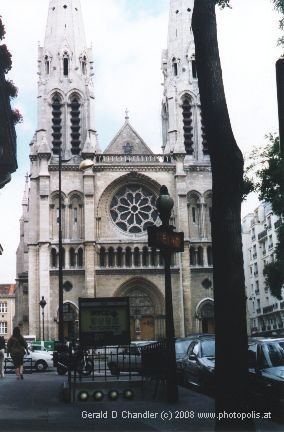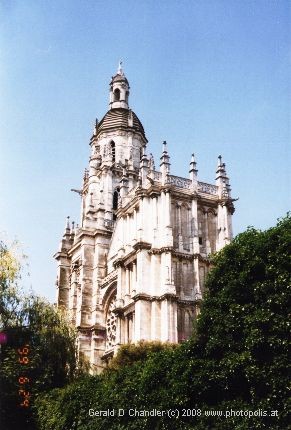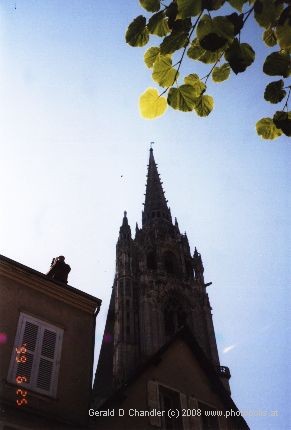Home | Front Page | Index | Blog | New | Contact | Site Map
Paris 1999 | Maps | Pics Day-by-day
Tourism
Daily Life
71 Rue de La Mare
Belleville
Computers
Metro
Objets Trouvés
Events
Gerry's Sketch
Hen Party
Jan's Birthday
Tour de France
Outings
Outside Paris
Fontainebleau
Giverny & West
Solar Eclipse
Versailles
Paris 1999
Paris 2005
Paris 2007
France 2007
Paris 2008
France 2008

Britain 1999
Beijing 1999
China 1999
Hong Kong 1999
Vietnam 2000
China 2000
There is no doubt that one could spend a lifetime studying the churches and cathedrals of France. Certainly in the weeks we have been here we have not gone much beyond surface impressions — and we have not seen anywhere near all the churches there are to see. For the most part we saw the less famous churches as an adjunct to a visit or walk nearby. Our interest is probably is bit stronger than that of most people. If we had the time, which we don't seem to, we'd visit them all, and visit them again, until we knew each of their personalities. As it is, here is an outline of what we did — and what we've missed.
In our first week in France we had a rental car and went outside of Paris where we saw the cathedrals at Evreux and Chartres. Evreux is west of Paris about 100 km; as it is only 40 km south of Rouen we were tempted to go back there; five years ago we had seen the three magnificent churches of that city. On August 11 we had another rental car, just for the day, to see the solar eclipse. After the eclipse we had planned to go to Reims, which we did. But before that our path took us to Soissons, and we were very glad to have stopped to see the cathedral there.
Within Paris, head and shoulders above all others in fame is the Cathedral of Notre Dame. But it is not the only large, imposing church. While among the oldest, is not the oldest; it has many modest predecessors. Below is a list of twenty five churches taken from our Michelin Green Guide for Paris. The Michelin mentions more than these twenty-five churches, but they are among the most interesting. We've been to most, but not all of them. For a few our visit was just to the outside. (Dare we plead lack of time again?)
Here's a list of churches we visited or thought about visiting. The order in the list is roughly that of their age or style. It's rather hard not to be a bit arbitrary here since almost every one of these churches was constructed over decades, even centuries, and then when "finished" underwent major changes due to partial destruction or changes in taste or expansion or revolution and later repair. Because we don't have much here you'll forgive us, please, for it being just a bit boring. Right now the list is a place holder for later adding more pictures and thoughts. (Hope we have time to do it!)
St Pierre de Montmartre, 1134-1800
This was the original church of the abbey on top of Montmartre. Only some eight hundred years later did it have to share its hill with the now much more famous Sacre Coeur. Until about 1860 Montmartre was still outside the city limits. We've taken all our guests to Montmartre but only Gerry has gone into the 11th century St. Pierre, as it is not obvious that visitors are welcome. But where is our photo?
Notre Dame 1163 - 1300
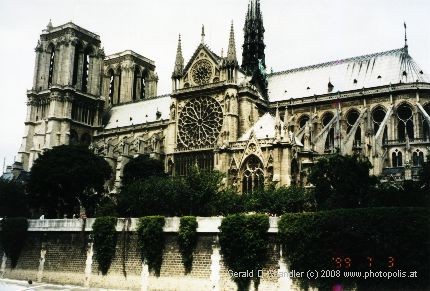
|
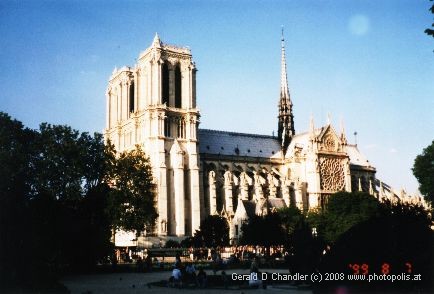
|
You can hardly take a bad photo of this old lady. We've been inside twice this trip and passed the outside a dozen times.
St Julien le Pauvre * 1165-1220, 1651
This ancient-looking church is in the Latin Quarter. We've only been on the outside.
La Sainte Chapelle, 1245 - 1248
We only made it here this week, so we don't have a photo developed yet. The church, built by Louis IX, also known as St. Louis, is composed of one stained glass window after another, with not a solid wall anywhere. The windows were done by the artisans of Chartres, in other words by the absolute masters of their day.
St Sèverin - St Nicolas ** 1250-1530
In the Latin Quarter on the rue St Jaques and near St Michel, we've walked by several times, and been in once. Its rather conveniently sited if all one is looking for is a place to rest ones feet. It is worth a visit for more than that, as its stained glass is a combination of old and ultra modern. A photo is at the developers.
St Germain l'Auxerrois 1435-1439
Opposite the Cour Carré (east) end of the Louvre, we have seen but not visited this church.
St Etienne du Mont ** 1492-1610
In the Latin Quarter next to the Pantheon, we have seen it but have not visited it.
St Germain des Prés 576, 1607
St. Germain is simply much larger and much more impressive than expected. The church is all that remains of an extensive religious complex. Its location in the heart of the Latin Quarter makes it one of the more famous of Paris's churches. Of course, its location opposite the Café Aux Deux Magots might help also.
Le Val de Grace ** 1645
About as far (south) from the Seine as you can be and still be in
the Latin Quarter is where this church is located. We have not even seen
it.
St Louis en L'Ile 1664-1726
A tiny church on the "other" island. Upstream from the Ile de la Cité is the Ile St Louis. The first has Notre Dame and is visited by everyone; this is hardly visited.
St Merri 1520-1612
Between the Centre Pompidou ( Beaubourg) and the Seine, this church can hardly be missed. About our third time walking by we went in. It should be famous because it is very nice.
|
St Sulpice 1500 - 1750A church with an imposing facade in the heart of the Latin Quarter. Far from our favorite, but the square and fountain in front are very pleasant. |
Invalides - Church of the Dome 1674-1706, 1735

|
The Church of the Dome was originally built as one of a pair of churches. The Church of the Dome side was for royalty; the other for old soldiers in the old soldiers home (hence the name Invalides).
The church was de-sanctified during the revolution and then in 1840 it was modified to become Napoleon's tomb. This picture was taken during our third visit in a quarter century. As we took lots of time to read everything it became even more impressive.
The dome of the Invalides is a small part of the picture at right, taken from the Madeleine looking at the Place de la Concorde and National Assembly. Our close up picture went with Gerry's lost camera.
Tour St. Jacques 1515-1589 (Francois I)
As we wandered around the various parts of Paris, we found ourselves often passing in front of, or espying from a distance, an isolated tower near the place du Châtelet which it took us a while to identify. Eventually we learned that it was once part of the church St. Jaques la Boucherie de Compostello, the starting point for pilgrimages to the Spanish St. Jacques in the middle ages. The church is long gone, alas, and only the tower remains.
Incidentally, the place du Châtelet is named after a castle which guarded the bridge to the Ile de la Cité; the castle is also long gone.
St Eustache 1532-1637
The church is lovely, impressive in its size and light that comes in. The pictures are still in the camera.
St Gervais - St Protais* 1616-1657
Located by the Seine near the City Hall in the district known as the Marais, we have never visited this church although one day we did rapidly walk by looking for a bus stop!
Notre Dame des Victoires, 1629-1740
We went in but did not take any photos that time. Our first photos went with Gerry's lost camera. It is now a fine neighborhood church. But it has quite a history.
St Roch on rue St Honoré 1719-1736
We should have gone in, having passed it many times, but only now have we read how famous it is.
Panthéon, 1758-1789Built as the church of Ste Geneviève, the patron saint of Paris, it was completed just as the French Revolution arrived. The revolution was anti-clerical and confiscated most church property. This building oscillated between secular and sacred use for several decades. It ended as the final resting place for great French authors, poets, scientists, and politicians including Victor Hugo, Pierre and Marie Curie, André Malraux, and hundreds of others. Not of course Napoléon, who is buried under the Dome at Invalides. |
|
|
La Madeleine 1764-1842The Madeleine was built as a church but like so many others became the property of the state during the revolution. Eventually it became a church again and is so to this day. Soon after our arrival in Paris, we went to an evening concert of Mozart's Requiem there. |
St Jean-Baptiste de Belleville - 1860This is hardly a famous church, but it is very well known to us since it is adjacent to the metro station that we use most often: Jordain. It is the Belleville neighborhood church and was built to house a large working class congregation. In spite of having passed many times in front of it, we have yet to cross its threshold. |
|
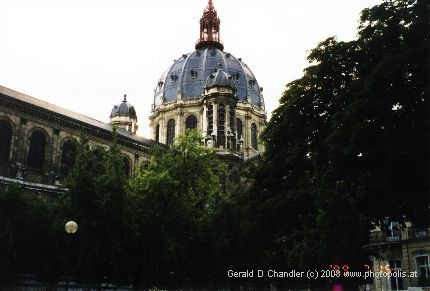
|
This a beautiful, imposing church which we first caught sight of one day when we were visiting La Madeleine
When you stand in front of the Madeleine, you can of course see straight ahead of you the Obelisk in the Place de la Concorde. If you turn your head to the right, you can also see the church of St.Augustin. As an aside, we both find these Paris perspectives-- the view along a boulevard from one monument to another — quite enchanting.
We have tried to visit St. Augustin on at least two occasions, both attempts were foiled by our late arrival. On one of these occasions we picnicked in the nearby Square de Marcel Pagnol named for the famous 20th Century novelist.
Le Sacré Coeur 1876-1914The French lost the Franco-Prussian war of 1870. A vow was then made that if Paris was saved from the German attack, a church would be built in thanksgiving. Paris was saved and the church built. It is nearly as much a landmark of Paris as the Eiffel tower, because it can be seen from so many places. It has a Greek rather than Latin layout and is decorated with many mosaics giving it a byzantine flavor. We take almost all of our visitors there. Partly because of the view of Paris available from the plaza in front of the church and partly because of the Place du Tertre, its cafes and artists just two blocks away. |
|
St Jean de Montmartre, -1904
This is a brick on re-inforced concrete church, the first one in Paris. Its lovely, and we don't have a photo.
La Cathédrale d'EvreuxNot famous and not grand, but very worth while. We spent more time at the adjoining museum, which is housed in old church buildings. That was lovely. We were surprised by how extensive it was, including extensive Roman artifacts. |
|
|
La Cathédrale de ChartresChartres is first rate. Only Notre Dame and the Rouen churches match it. We visited in, we think, 1981. Jan has remembered ever since the breakfast coffee and "tartine beurée" she had at a little cafe facing the cathedral. This time we ate in a restaurant some blocks away that didn't particularly please us and the cup of coffee Jan finally got across from the cathedral gave her sticker shock! The main attraction here is the stained glass windows which make the church very dark and mysterious. But beyond that it is a wonderful example of gothic architecture at its finest and is endowed with some fine examples of sculpture. |
Soissons and Reims
Our photos aren't available yet. These churches impress as being about equal size, but very different in every other way. Soissons is exceedingly well lighted and open, but has no stained glass to speak of. Reims is the opposite. One chapel has a set of stained glass done by Marc Chagal. Jan didn't like it; Gerry thought he would warm to it.




